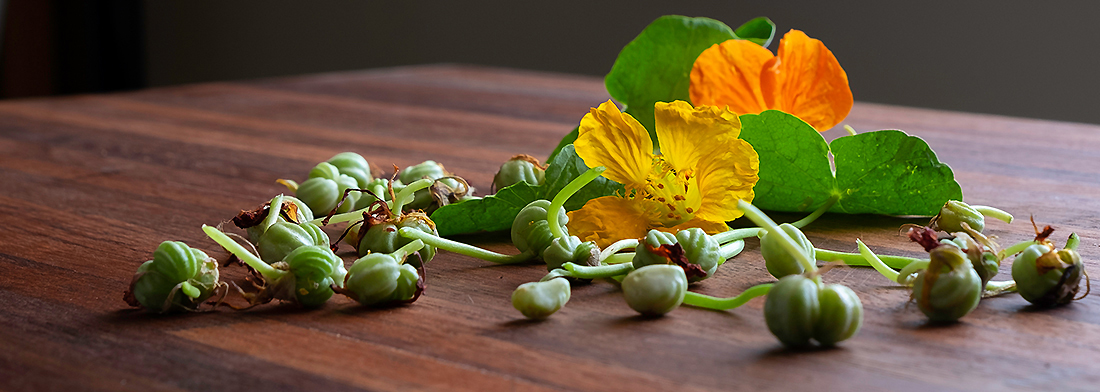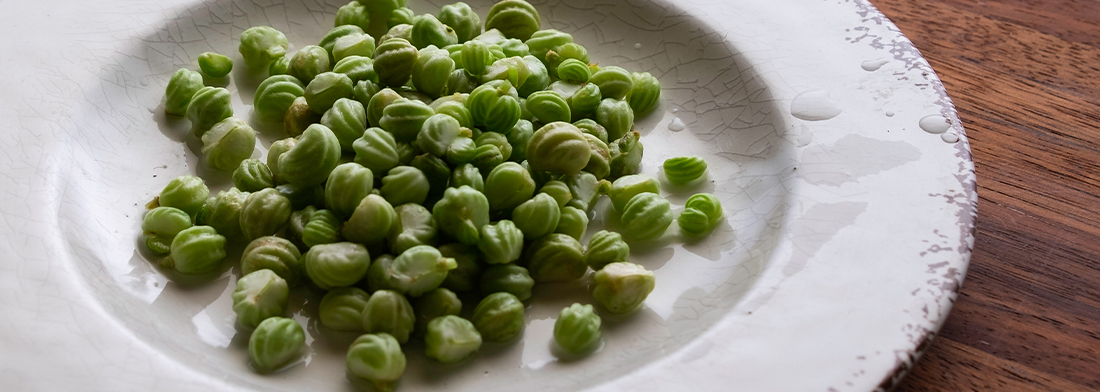Pickled Nasturtium Seeds
- Pickles, Chutney, Relish & Sauces

The seductive pungent and spicy taste of nasturtiums, that lingers pleasantly in the mouth, is a kitchen gardener’s delight. The vibrant rambling yellow and orange summer flowers and intense green foliage add a refreshing watercress-like pungency to salads. When the soft green seeds are pickled it offers a flavour bomb as a stand-alone condiment to egg and fish dishes as well as being an important additive to vinaigrette and mayonnaise-based dressings and other sauces.
For this recipe gather the seeds in the cool of the morning while they are fresh and plump, about 4-5 days after the flowers have fallen off. Unless you have access to many plants it’s likely you will be preserving small batches. Given the seeds are used as a condiment similar to or as an alternative to capers, small jars will go a long way. Enjoy the serenity of an early morning harvest and preparing the seeds before the ancient craft of slow preserving begins.
- Preparation Time:
- 45 minutes (over 3 days)
- Cooking Time:
- 10 minutes
- Quantity:
- 2 x 80 ml jars
PREPARATION
Warm sterilised dry sealable glass jars and lids.

INGREDIENTS
- 1 cup
- Fresh water
- 1.5 tablespoons
- Salt
- 1 cup
- White wine vinegar
- 1
- Shallot, sliced
- 3
- Cloves, whole
- 4
- White peppercorns
- small pinch
- Nutmeg, freshly grated
- few leaves
- French tarragon, fresh
METHOD
This method is suited to preserving small quantities and the brine solution and spiced vinegar solution can be scaled according to the volume of seeds gathered over 2-3 days.
Gather nasturtium seeds in the coolness of the morning. Wash to remove any garden debris and dirt.
Pull the seed pods apart into single seeds.
Make a brine solution by warming the water, add the salt and stir occasionally until all the salt is dissolved.
Cover the seeds with the brine and allow to soak for three days. Change the water daily. After 3 days drain in a strainer and dry on a cloth.
Make a spiced vinegar by placing the white vinegar, sliced shallots, peppercorns and salt and grated nutmeg to taste, into a pan. Bring to the boil and simmer gently for 10 minutes. Allow to cool and strain. Discard the seed mixture.
Place the nasturtium seeds into the prepared jars with a few fresh clean tarragon leaves.
Pour cooled vinegar over the seeds, leaving approximately 1 cm headspace in the jar.
Seal, label and store in a cool dark place in the kitchen or pantry.
Allow the jam to mature for at least 2 weeks before eating.
NOTES
- It’s important to dry the seeds after soaking in brine to prevent the dilution of the vinegar solution.
- The amount of tarragon can be varied according to taste. French tarragon (Artemisia dracunculus) is the bitter aromatic culinary herb to use in cooking, not Russian tarragon. It has a distinctive intense anise, liquorice and camphor that is one of the four official “fines herbs” recommended by the famous French chef Augstine Escoffier in the early 20th century. Russian tarragon grows more abundantly, however it has little taste and often considered as an impostor by culinary officiados.
- Only use fresh grated horseradish. Prepared horseradish condiments are likely to contain undisclosed ingredients which could affect the consistency of the seeds, the flavour and clarity of the vinegar and its storage capacity.
- Alternative flavourings include fennel seed, coriander seeds, chillies, thyme, rosemary.
- Large intakes of nasturtiums are not recommended as they have components that may irritate the digestive system and kidneys in some people.
